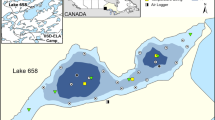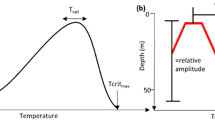Abstract
Circadian rhythms occur widely amongst living organisms, often in response to diel changes in environmental conditions. In aquatic animals, circadian activity is often synchronised with diel changes in the depths individuals occupy and may be related to predator–prey interactions, where the circadian rhythm is determined by ambient light levels, or have a thermoregulatory purpose, where the circadian rhythm is governed by temperature. Here, these two hypotheses are examined using animal-attached accelerometers in juvenile freshwater sawfish occupying a riverine environment displaying seasonal changes in thermal stratification. Across seasons, diel patterns of depth use (shallow at night and deep in the day) tended to occur only in the late dry seasons when the water was stratified, whereas individuals were primarily shallow in the early dry season which featured no thermal stratification. Activity was elevated during crepuscular and nocturnal periods compared to daytime, regardless of the thermal environment. Our observation of resting at cooler depths is consistent with behavioural thermoregulation to reduce energy expenditure, whereas activity appears linked to ambient light levels and predator–prey interactions. This suggests that circadian rhythms in activity and vertical migrations are decoupled in this species and respond to independent environmental drivers.




Similar content being viewed by others
References
Campbell, H. A., R. G. Dwyer, M. Gordos & C. E. Franklin, 2010. Diving through the thermal window: implications for a warming world. Proceedings of the Royal Society B: Biological Sciences 277(1701): 3837–3844.
Clark, T. D., E. Sandblom, S. G. Hinch, D. A. Patterson, P. B. Frappell & A. P. Farrell, 2010. Simultaneous biologging of heart rate and acceleration, and their relationships with energy expenditure in free-swimming sockeye salmon (Oncorhynchus nerka). Journal of Comparative Physiology B: Biochemical, Systemic, and Environmental Physiology 180(5): 673–684.
Di Santo, V. & W. Bennett, 2011. Is post feeding thermotaxis advantageous in elasmobranch fishes? Journal of Fish Biology 78(1): 195–207.
DiGirolamo, A., S. Gruber, C. Pomory & W. Bennett, 2012. Diel temperature patterns of juvenile lemon sharks Negaprion brevirostris, in a shallow-water nursery. Journal of Fish Biology 80(5): 1436–1448.
Douglas, M. M., S. E. Bunn & P. M. Davies, 2005. River and wetland food webs in Australia’s wet–dry tropics: general principles and implications for management. Marine and Freshwater Research 56(3): 329–342.
Gannon, R., M. D. Taylor, I. M. Suthers, C. A. Gray, D. E. van der Meulen, J. A. Smith & N. L. Payne, 2014. Thermal limitation of performance and biogeography in a free-ranging ectotherm: insights from accelerometry. Journal of Experimental Biology 217(17): 3033–3037.
Gillooly, J. F., J. H. Brown, G. B. West, V. M. Savage & E. L. Charnov, 2001. Effects of size and temperature on metabolic rate. Science 293(5538): 2248–2251.
Gleiss, A. C., S. H. Gruber & R. P. Wilson, 2009. Multi-channel data-logging: towards determination of behaviour and metabolic rate in free-swimming sharks. In Nielsen, J. L., H. Arrizabalaga, N. Fragoso, A. Hobday, M. Lutcavage & J. Sibert (eds), Tagging and Tracking of Marine Animals with Electronic Devices. Springer, New York: 213–228.
Gleiss, A. C., J. J. Dale, K. N. Holland & R. P. Wilson, 2010. Accelerating estimates of acvtivity-specific metabolic rate in fish: testing the applicability of acceleration data-loggers. Journal of Experimental Marine Biology and Ecology 385(1–2): 85–91.
Gleiss, A. C., R. P. Wilson & E. L. C. Shepard, 2011. Making overall dynamic body acceleration work: on the theory of acceleration as a proxy for energy expenditure. Methods in Ecology and Evolution 2(1): 34–42.
Gleiss, A. C., S. Wright, N. Liebsch, R. P. Wilson & B. Norman, 2013. Contrasting diel patterns in vertical movement and locomotor activity of whale sharks at Ningaloo Reef. Marine Biology 160(11): 2981–2992.
Halsey, L. G., E. L. C. Shepard, F. Quintana, A. Gomez Laich, J. A. Green & R. P. Wilson, 2008. The relationship between oxygen consumption and body acceleration in a range of species. Comparative Biochemistry and Physiology, Part A 152(2): 197–202.
Hays, G. C., 2003. A review of the adaptive significance and ecosystem consequences of zooplankton diel vertical migrations. Hydrobiologia 503(1): 163–170.
Jacoby, D. M., P. Siriwat, R. Freeman & C. Carbone, 2015. Is the scaling of swim speed in sharks driven by metabolism? Biology Letters 11(12): 20150781.
Kavanau, J. L. & J. Ramos, 1975. Influences of light on activity and phasing of carnivores. The American Naturalist 109(968): 391–418.
Kelber, A., E. J. Warrant, M. Pfaff, R. Wallén, J. C. Theobald, W. T. Wcislo & R. A. Raguso, 2006. Light intensity limits foraging activity in nocturnal and crepuscular bees. Behavioral Ecology 17(1): 63–72.
Lowe, C. G. & K. J. Goldman, 2001. Thermal and bioenergetics of elasmobranchs: bridging the gap. Environmental Biology of Fishes 60(1–3): 251–266.
Mastrorillo, S. & G. Copp, 2005. Diel dynamics of young and small fishes in a side-channel of the River Garonne, France, before and after a late-summer spate. In Annales De Limnologie-International Journal of Limnology, Vol. 41. EDP Sciences: 15–25.
Morgan, D., J. Whitty, N. Phillips, D. Thorburn, J. Chaplin & R. McAuley, 2011. North-western Australia as a hotspot for endangered Elasmobranchs with particular reference to sawfishes and the Northern river Shark. Journal of the Royal Society of Western Australia 94(2): 345–358.
Neill, W. E., 1990. Induced vertical migration in copepods as a defence against invertebrate predation. Nature 345: 524–526.
Nelson, D. R., J. N. McKibben, W. R. Strong Jr., C. G. Lowe, J. A. Sisneros, D. M. Schroeder & R. J. Lavenberg, 1997. An acoustic tracking of a megamouth shark, Megachasma pelagios: a crepuscular vertical migrator. Environmental Biology of Fishes 49(4): 389–399.
Papastamatiou, Y. P., Y. Y. Watanabe, D. Bradley, L. E. Dee, K. Weng, C. G. Lowe & J. E. Caselle, 2015. Drivers of daily routines in an ectothermic marine predator: hunt warm, rest warmer? PLoS One 10(6): e0127807.
Payne, N. L., B. M. Gillanders, R. S. Seymour, D. M. Webber, E. P. Snelling & J. M. Semmens, 2011. Accelerometry estimates field metabolic rate in giant Australian cuttlefish Sepia apama during breeding. Journal of Animal Ecology 80(2): 422–430. doi:10.1111/j.1365-2656.2010.01758.x.
Payne, N. L., D. E. van der Meulen, R. Gannon, J. M. Semmens, I. M. Suthers, C. A. Gray & M. D. Taylor, 2013. Rain reverses diel activity rhythms in an estuarine teleost. Proceedings of the Royal Society of London B: Biological Sciences 280(1750): 20122363.
R Development Core Team, 2010. R: a language and environment for statistical computing. R Foundation for Statistical Computing, Vienna.
Sakamoto, K. Q., K. Sato, M. Ishizuka, Y. Watanuki, A. Takahashi, F. Daunt & S. Wanless, 2009. Can ethograms be automatically generated using body acceleration data from free-ranging birds? PLoS One 4(4): e5379.
Shepard, E. L. C., R. P. Wilson, L. G. Halsey, F. Quintana, A. Gómez Laich, A. C. Gleiss, N. Liebsch, A. E. Myers & B. Norman, 2008. Derivation of body motion via appropriate smoothing of acceleration data. Aquatic Biology 4(3): 235–241.
Sims, D. W., V. J. Wearmouth, E. J. Southall, J. M. Hill, P. Moore, K. Rawlinson, N. Hutchinson, G. C. Budd, D. Righton, J. Metcalfe, J. P. Nash & D. Morritt, 2006. Hunt warm, rest cool: bioenergetic strategy underlying diel vertical migration of a benthic shark. Journal of Animal Ecology 75(1): 176–190.
Thiem, J., J. Dawson, A. Gleiss, E. Martins, A. Haro, T. Castro-Santos, A. Danylchuk, R. Wilson & S. Cooke, 2015. Accelerometer-derived activity correlates with volitional swimming speed in lake sturgeon (Acipenser fulvescens). Canadian Journal of Zoology 93(8): 645–654.
Thorburn, D. C., D. L. Morgan, A. J. Rowland & H. S. Gill, 2007. Freshwater sawfish Pristis microdon Latham, 1794 (Chondrichthyes: Pristidae) in the Kimberley region of Western Australia. Zootaxa 1471: 27–41.
Tsuda, Y., R. Kawabe, H. Tanaka, Y. Mitsunaga, T. Hiraishi, K. Yamamoto & K. Nashimoto, 2006. Monitoring the spawning behaviour of chum salmon with an acceleration data logger. Ecology of Freshwater Fish 15(3): 264–274.
Vianna, G. M. S., M. G. Meekan, J. J. Meeuwig & C. W. Speed, 2013. Environmental influences on patterns of vertical movement and site fidelity of grey reef sharks (Carcharhinus amblyrhynchos) at aggregation sites. PLoS One 8(4): e60331.
Warfe, D., N. Pettit, P. Davies, B. J. Pusey, S. Hamilton, M. J. Kennard, S. Townsend, P. Bayliss, D. Ward & M. Douglas, 2011. The ‘wet–dry’in the wet–dry tropics drives river ecosystem structure and processes in northern Australia. Freshwater Biology 56(11): 2169–2195.
Warton, D. I. & F. K. C. Hui, 2011. The arcsine is asinine: the analysis of proportions in ecology. Ecology 92(1): 3–10.
Whitney, N., H. J. Pratt, T. Pratt & J. Carrier, 2010. Identifying shark mating behaviour using three-dimensional acceleration loggers. Endangered Species Research 10: 71–82.
Whitney, N. M., Y. P. Papastamatiou & A. C. Gleiss, 2012. Integrative multi-sensor tagging of elasmobranchs: emerging techniques to quantify behavior, physiology, and ecology. In Carrier, J. C., M. R. Heithaus & J. A. Musick (eds), Biology of Sharks and Their Relatives, Vol. 2. CRC Press, Boca Raton.
Whitney, N. M., K. O. Lear, L. C. Gaskins & A. C. Gleiss, 2016. The effects of temperature and swimming speed on the metabolic rate of the nurse shark (Ginglymostoma cirratum, Bonaterre). Journal of Experimental Marine Biology and Ecology 477: 40–46.
Whitty, J., 2011. Utility of a Multi-Faceted Approach in Determining the Habitat use of Endangered Euryhaline Elasmobranchs in a Remote Region of Northern Australia. Murdoch University, Murdoch.
Whitty, J. M., D. L. Morgan, S. C. Peverell, D. C. Thorburn & S. J. Beatty, 2009. Ontogenetic depth partitioning by juvenile freshwater sawfish (Pristis microdon: Pristidae) in a riverine environment. Marine and Freshwater Research 60: 306–316.
Wilson, R. P., C. R. White, F. Quintana, L. G. Halsey, N. Liebsch, G. R. Martin & P. J. Butler, 2006. Moving towards acceleration for estimates of activity-specific metabolic rate in free-living animals: the case of the cormorant. Journal of Animal Ecology 75(5): 1081–1090.
Wood, S. N., 2006. Generalized Additive Models: an Introduction with R. Chapman and Hall/CRC, Boca Raton.
Wueringer, B. E., L. Squire, S. M. Kajiura, N. S. Hart & S. P. Collin, 2012. The function of the sawfish’s saw. Current biology : CB 22(5): R150–R151.
Yerushalmi, S. & R. M. Green, 2009. Evidence for the adaptive significance of circadian rhythms. Ecology letters 12(9): 970–981.
Zuur, A. F., E. N. Ieno, N. J. Walker, A. A. Saveliev & G. M. Smith, 2009. Mixed Effects Models and Extensions in Ecology with R. Springer, NewYork.
Acknowledgements
We greatly acknowledge the involvement of the Nyikina-Mangala Rangers and the people of the Kimberley region of Western Australia. ACG is the recipient of an Australian Research Council Discovery Early Career Research Award (Project number 150100321), fieldwork was funded by the Fisheries Society of the British Isles, Australia Pacific Science Foundation, the Waitt Foundation, Western Australian Government State Natural Resource Management Program and Murdoch University. We would like to thank two anonymous referees (#2 in particular) whose crticisms greatly improved this paper.
Author information
Authors and Affiliations
Corresponding author
Additional information
Handling editor: I. A. Nagelkerken
Rights and permissions
About this article
Cite this article
Gleiss, A.C., Morgan, D.L., Whitty, J.M. et al. Are vertical migrations driven by circadian behaviour? Decoupling of activity and depth use in a large riverine elasmobranch, the freshwater sawfish (Pristis pristis). Hydrobiologia 787, 181–191 (2017). https://doi.org/10.1007/s10750-016-2957-6
Received:
Revised:
Accepted:
Published:
Issue Date:
DOI: https://doi.org/10.1007/s10750-016-2957-6




